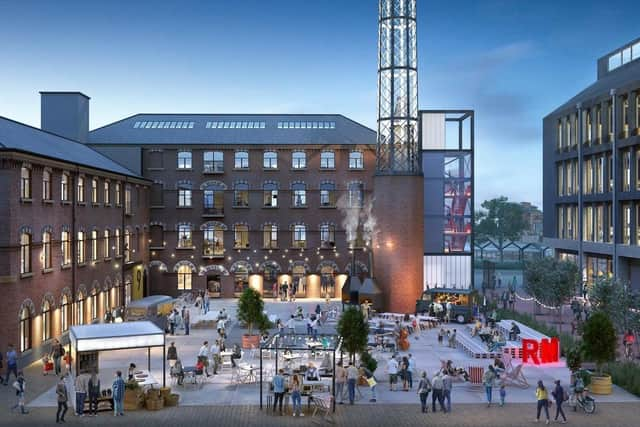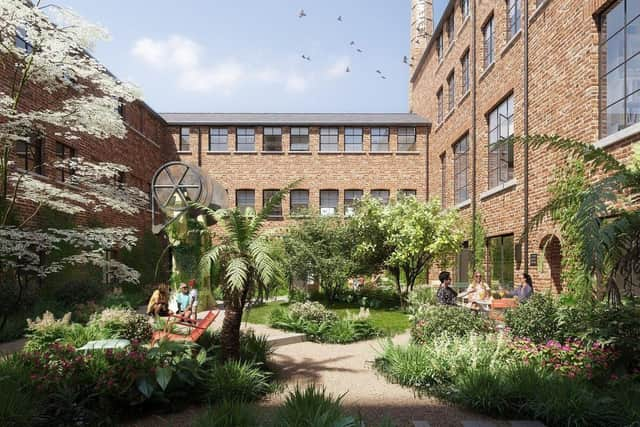Inside Yorkshire's almost forgotten warehouses which have been transformed
Sadly, over time, a lot of the factories and warehouses have since closed with jobs being lost and areas falling into deep poverty.
However, in recent times however there has been a revival of our once forgotten buildings. Here’s a round up of some of the former warehouses which have been transformed.
Advertisement
Hide AdAdvertisement
Hide AdTileyard North at Rutland Mills, Wakefield


A new boutique hotel, an eco-friendly 40,000 sq ft office space and professional recording studios are set to launch in the latest stage of the development of a Grade II-Listed mill complex in Yorkshire.
Following the multi-million pound restoration of the disused Rutland Mills, Tileyard North on Wakefield’s waterfront is dubbed as becoming ‘the largest creative community outside of London.
Peddler Market, Kelham Island, Sheffield
Another notable Yorkshire community which competes - and in our opinion beats - southern counterparts is the Kelham Island area of Sheffield.


Peddler Warehouse, based at 92 Burton Road, is a 7,500 sq.ft ex-industrial warehouse turned independent food hall and event space.
Advertisement
Hide AdAdvertisement
Hide AdIt’s extremely popular and opens on the first Friday and Saturday of every month. It’s also expanding and will be popping up at Tileyard North in their courtyard in Wakefield.
Cutlery Works Food Hall at Cutlery Works, Neepsend, Sheffield
The industrial heart of Sheffield includes Neepsend where there is another popular food hall.
Cutlery Works is the largest food hall in the North of England, spread out over two floors featuring a mixture of permanent and semi-permanent unique.
From bottomless brunches to a dog-friendly space, you can see why it was voted one of the best food halls last year.
Advertisement
Hide AdAdvertisement
Hide AdThe first phase of development came in the late 1990s, when businesses such as Yellow Arch Studios and The Milestone pub moved in and Brooklyn Works, a former metal factory, became the first residential conversion.
These are just a couple of places which have helped to save the area and take Kelham Island off Historic England’s “at risk” register in 2019.
The first phase of development of the area came in the late 1990s, when businesses such as Yellow Arch Studios and The Milestone pub moved in and Brooklyn Works, a former metal factory, became the first residential conversion.
Temple Works, Leeds
Another area which has had a massive face lift is Temple Works in Leeds, which is home to a former Flax Mill with unique features.
Advertisement
Hide AdAdvertisement
Hide AdTemple Works, in Holbeck, was awarded more than £1 million in grants from the government’s Culture Recovery Fund and Historic England in 2022.
Historic England said it will restore the Grade I-Listed building to its former glory, which was famous for its striking Egyptian architecture and stories of sheep grazing on the roof.
It said: “One of the first large-scale, single-storey factories, the vast brick-vaulted, top-lit spinning mill was constructed between 1838 and 1840 to the designs of the engineer James Coombe.
“Here, the Victorian mill owners hoisted sheep onto the roof to graze on grass grown to maintain humidity in the building, reportedly to stop the flax from breaking, creating a spectacle that drew visitors from far and wide.”
Advertisement
Hide AdAdvertisement
Hide AdWhile the area has become synonymous with office blocks and residential properties, before Temple Works is fully refurbished it is undergoing a massive renovation project to make sure the building is watertight.
On the restoration, Councillor Helen Hayden, Leeds City Council’s Executive Member for Infrastructure and Climate, said: "This is a bold and ambitious project which will repurpose an important part of our city’s heritage and help drive wider regeneration in Leeds’s South Bank area and beyond.
“This new funding is welcome and will enable progress to be made on the plans at Temple Works, including much-needed repair work to the Counting House."
Sunny Bank Mills, Farsley, Leeds
Sunny Bank is an example of a place that has already been converted into a commercial and cultural destination.
Advertisement
Hide AdAdvertisement
Hide AdThe mills were founded in 1829 and have been regenerated by the sixth generation of the family owners, who have a wonderful blend of work, leisure and culture.
Sunny Bank Mills offers beautifully restored creative business spaces for both small and large organisations. Sunny Bank Mills Gallery is the epicentre of our arts programme, spanning exhibitions, workshops, studio spaces and events, and the Sunny Bank Mills Archive protects and promotes the history of the mill and the community.
Salts Mill in Saltaire Village, Bradford
A former ‘industrial powerhouse’ Salts Mill opened in 1853, and became a landmark place for cloth production in Saltaire, a Unesco World Heritage Site. It is now a thriving arts and culture hub.
When the mill closed in 1986, the following year the mill was purchased by the late Jonathan Silver, who had a vision of culture and commerce thriving together.
Advertisement
Hide AdAdvertisement
Hide AdIt is most well-known as the home of David Hockney’s artwork as well as a number of visiting exhibitions.
Beaverworks in Hunslet, Leeds
A former industrial warehouse turned events, festival and raving venue. This converted warehouse may be a bit rough around the edges but it holds some of the best events from everyone from students to dance music enthusiasts. It is also home to the LDC Radio station.
Dean Clough at Clough Mills, Halifax
Clough Mills was home to one of the largest carpet manufacturers in the world, Crossley Carpets.
Dean Clough is now a thriving 22-acre mixed-use mill complex, stretching half a mile in length and consisting of 16 Grade II listed Victorian mills. The complex now offers spaces to work, eat, drink, shop and experience a range of cultural activities with a theatre, art gallery and event space.
Advertisement
Hide AdAdvertisement
Hide AdPiece Hall, Halifax
The Grade I-listed Piece Hall, Halifax is a rare and precious thing, an architectural and cultural phenomenon which is absolutely unique.
It is the sole survivor of the great eighteenth century northern cloth halls, a class of buildings which embodied the vital and dominant importance of the trade in hand woven textiles to the pre-industrial economy of the West Riding of Yorkshire, from the Middle Ages through to the early nineteenth century. It is one of Britain’s most outstanding Georgian buildings.
Today Piece Hall is a shopping, music and entertainment destination which has a stunning open air courtyard in the centre surrounded by shops, cafes and boutiques.
The Fruit Market, Hull
Hull is a favourite shipping destination with a history of being the trading port where fruit and vegetables came fresh off ships. At its height, 20,000 lettuce were sold by the Fruit Market's wholesalers every week.
Advertisement
Hide AdAdvertisement
Hide AdIn 2009, the area - centred on Humber Street - fell silent after Hull City Council removed the remaining traders to a new out-of-town site. The Fruit Market was to be redeveloped - until the recession put the brakes on, and the empty, desolate buildings originally scheduled for demolition were instead colonised by artists and creative types who 'self-gentrified' the area, looking for cheap studio space.
Bars, cafes, arts venues and galleries sprang up in the old fruit exchanges and merchants' premises along Humber Street to serve this new community, and eventually the developers' investment returned. Now, it has also become a desirable residential area.
